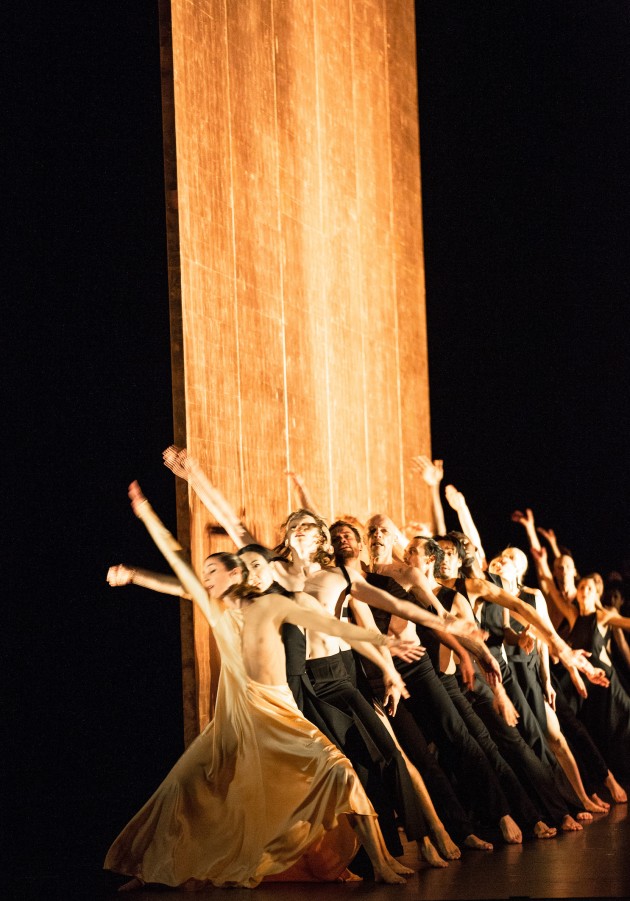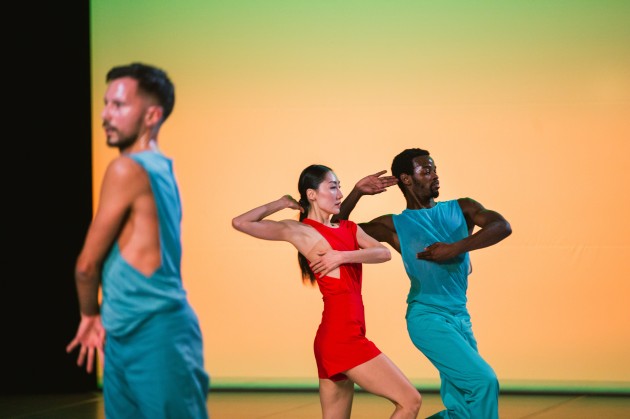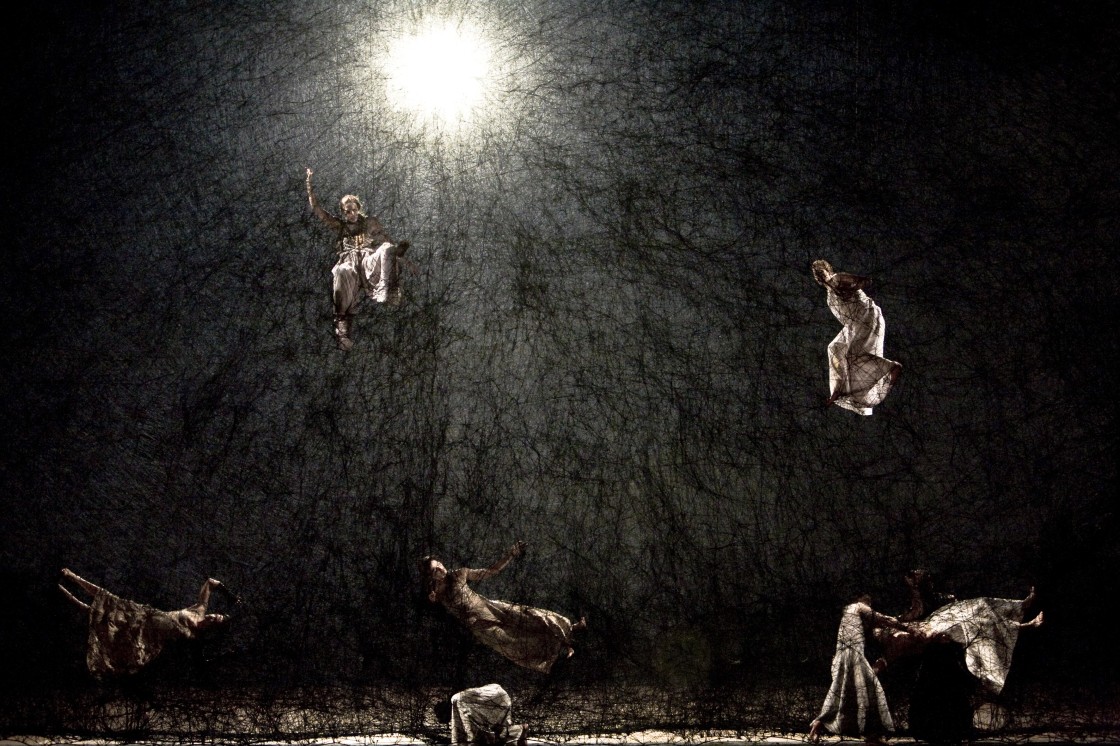Dance against global threats

Monika Pilch: The performance "SYM-PHONIE MMXX for dance, light and orchestra" performed by Sasha Waltz & Guests - opened the Łódź Ballet Meetings. You worked on this performance with the composer Georg Friedrich Haas, who specially wrote the music for this performance. It was also the first ballet, he composed. How did the work look like?
Sasha Waltz : When I met Georg Friedrich Haas, I knew I wanted to create a ballet with an original music. At first, we talked about possible topics of the piece, but also about the problems of our modern world. The discussion included issues such as emancipation, "Black Lives Matter", freedom movements, the climate crisis, but also natural disasters such as fire and drought. All these themes became the basis for writing the composition. The music was recorded in 2019 by the Staatskapelle Berlin. When I received the music, I started working on the choreography until the beginning of the first lockdown - March 13, 2020.
The pandemic delayed the release date. Did it also influence the final shape of this performance?
Not really. When the pandemic broke out, the piece was basically built. When we were able to pick up rehearsals again, I changed some parts, but the core of this production remained untouched.
In your work, you touch many different fields, such as opera, classical ballet, contemporary dance or site-specific projects. Do you have your favorite path that you are following?
The center of my work is always choreography and body work, whether I direct operas or choreograph dance performances. I only change my perspective. In opera, I not only work with dancers, but also with singers and a choir, and in the creation process I try to pay attention to the singers' physicality. It is important to me to make their presence visible, to make dancers and singers one creative body on stage. When I work on site-specific projects, the most important for me is the architecture. Thus, the movement of the body is always in dialogue with the surrounding architecture. It is important for me to ask questions, to think about the means of expression I use, and I am curious about the world and people. So in my work I always strive to expand my horizon, let myself be inspired by new areas and topics I learn about and bring them in dialogue with dance.
Scenography is very important in your performances.
Yes. The set design and space are extremely important in my thinking about the piece. I like working on site-specific projects because I am fascinated when space determines my actions and I need to try answering the questions posed by this space without being able to change it.
When it comes to the dance theatre tradition - do you refer to a specific school or trend that builds your language?
I certainly have my own language or handwriting, also because of my interest in opera and other art forms. Each time I want the viewer to experience something new. When I think about my creative path, in retrospect, I see that in my work there are certain cycles and recurring areas of interest.
Artists usually don't like labelling their achievements. Can you define the stages of your creative activity?
I think so. I would describe the beginning of my career as a social realism. I mainly dealt with the reflection and transformation of the movement of everyday life. In the next period of my artistic path the topics became more philosophical and the movement more abstract.
And then there are my choreographic opera works, often baroque music, that have a narrative layer woven into the abstract dance.
My latest project, "In C", marks a new chapter. It is a very conceptual and abstract work. I would like to explain this a bit more extensively. This is also due to the music by Terry Riley, on which the choreography is based. I always work closely with the music. “In C” is a milestone in minimal music, the composition consists of 53 musical figures and a set of rules of how to perform them. For “In C” I wanted to find a suitable language that works similarly to the composition. So, I created 53 choreographic figures and a set of rules of how to perform them in space. That means each dancer has a lot of freedom, but at the same time always has to be aware of the rest of the group in the performance. It is a combination of improvisation and choreography. In the creation process we talked primarily about space and composition, not about a role or emotion. „In C” for me really is a show about how we work together as a society and perhaps it will once again lead to a change in the choreographic language I use.
I would like to go back to the beginnings of your creative path. You grew up in West Germany, then studied in Amsterdam, lived in New York, and finally you left New York to settle down in Berlin. What determined such a career path?
I had the dream to become a contemporary dancer and choreographer. But you couldn’t study contemporary dance anywhere in Europe at that time. So I moved to Amsterdam to study, and later to New York. But I also travelled a lot teaching and performing. I didn’t think that I would come back to Germany. But then the wall came down and I moved to Berlin, because it seemed to me that this city at that time had an extraordinary energy and potential of transformation. The dance scene in Berlin was still developing when I arrived in the early nineties, and was rather small with no existing infrastructure, so we had to create the structures in which we could work. In 1996 Jochen Sandig and I co-founded the Sophiensaele as a space for contemporary dance and performance. The dance scene in Berlin has since grown and is very diverse and alive. I have the impression that today's Berlin resembles New York in the 1980s. Berlin still fascinates me precisely because it is still changing.
Has this situation changed?
I think Berlin is still a very creative place. It is a city not only for dance and the performing arts, but for many artists, so the exchange of creators is very vibrant.
After your studies, you did not return to Amsterdam for good, do you regret your decision?
No, not at all. I liked Amsterdam very much and I have great memories of my studies, but I was looking to advance my professional career. Even though it is a picturesque city, at the time it lacked creative potential for me. Even in the nineties, Berlin offered much more possibilities. The number of creative initiatives was countless. Artists used to come to Berlin, because after the fall of the Berlin Wall, there were many uninhabited buildings, empty spaces, where dance studios, galleries and ateliers were created. Living costs were relatively low, which too made Berlin attractive for artists.

After many years of creative work in Berlin, you became the director of Staatsballett Berlin, the largest German classical ballet company. Has this experience changed your creative perspective? Did it influence the shape of your choreography?
It has changed my perspective on classical institutions and redefined for me what are ideal conditions for creating art. And I find them more alive in independent structures.
If you have your own team, how do you choose its members?
There is a steady group of artists with whom I work regularly, but of course I also recruite for new projects. When I am on the lookout, technical skills are of course the basis, but I am also interested in the dancer’s personality, creativity and individual way of moving. I used to do auditions, but now I choose dancers during workshops. This way I have more contact with them and can make more objective decisions. It is also very important for me to see how a dancer works in a group.
I know you have a butoh dancer in your team. How important are these different traditions from which the dancers come?
Most of them are contemporary dancers or have experience of contemporary and classical dance. Different dance traditions mean that dancers perform specific tasks in different ways, which is very inspiring.
Can you see the generation change? Will dancers today be more willing to combine the tradition of contemporary dance and classical ballet?
Yes, although this is often influenced by the school they trained in. I see enormous determination and willingness to work in young dancers, they are interested in new practices and working with contemporary choreographers. But sometimes young people tend to focus on their technique and still lack expression and freedom of the mind. A lot of classical education is still entrapped in toxical thinking about the body: Are dancers slim enough, what do the bodies look like. Contemporary perspectives on the human body, gender equality and diversity - these are some of the important topics that the dance world of today needs to tackle if we really want transformation in dance.
Is creativity something we can learn?
Of course. There are classes in composition in contemporary dance schools. There one can learn how to improvise, compose, organize space, and maintain contact with other dancers. But besides all the techniques that can be learned, being open and aware are a key to creativity. Improvisation is more than just finding the right steps, it is also reaching into yourself. Then you can find your own movements, your own identity as an artist.
Since education has such a strong influence on the thinking of choreographers about dance, which dance schools - in your opinion, are progressive in thinking about dance?
SEAD in Salzburg, many outstanding dancers come from there. P. A. R. T.S. in Brussels, dance schools in Essen, Frankfurt and the United States. Many talented dancers and choreographers have studied there.
Do you have any dance masters? People who you follow in this field?
It is difficult for me to point out one particular person, there are different artists both in the field of visual arts and music whose work I follow. In my youth, I was especially inspired by experimental artists from New York such as Trisha Brown, Simone Forti and Yvonne Rainer. They had a huge impact on my way of thinking about dance. Today a source of inspiration for me is often music.
You also worked at the Grand Theatre in Warsaw on the choreography for the opera "Matsukaze" by Japanese composer Toshio Hosokawa.
Working with artists from different cultures is important to me. The creative language of dance is a tool of rich intercultural exchange.
Do you have your own artistic dreams?
As artists we should actively participate in social changes. My performance "In C" to the music by Terry Riley for example is a presentation of democracy on stage. It shows how we could live together and function as a society that gives freedom to the individual while never forgetting the collective. My dream is to share these democratic values and to work in peaceful collaborations.
Do you treat your performances as a kind of public statements, an appeal on stage?
For me, art enables people to unite in peace, to come together in a space no matter where you come from, what gender you are or what your beliefs. In a theatre during a performance we breathe together and look at the same piece, this gives us a sense of community. Art also allows us to understand other cultures, create new points of reference, and gives us a different perspective on our reality. This is especially important in view of the crisis of values that we are experiencing today. The future appears to be full of threats to living creatures. I don't mean just small communities, but globally, not only through war and cruelty, but also through the ongoing enormous climatic changes. As artists, we should set an example, not only by creating works that reflect and discuss the new reality, but also by changing our lives. This is not the time to wake up, this is the time to act.
